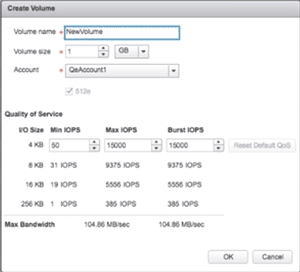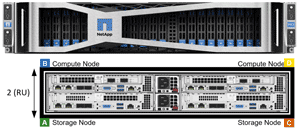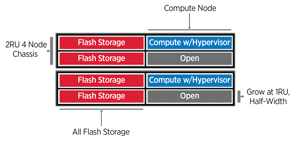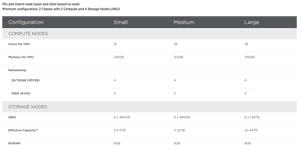How-To
A Quick Look at NetApp Hyper-Converged Infrastructure
It uses SolidFire storage and vSphere to scale up.
Following an announcement at its Insight conference, NetApp released its hyper-converged infrastructure (HCI) platform on Oct. 25. But what is HCI, and why is now such an important time for NetApp to be offering this platform?
HCI combines compute and storage into a single scalable platform, and controls it through a single management platform. This level of convenience and efficiency has made HCI the fastest growing segment in the datacenter, seeing about 50 percent growth in Q2 2017.
Moreover, with many experts predicting that this growth will reach $8 billion in 2020, it seems like a great time to bring an HCI platform to the market. But will NetApp's HCI offering bring something unique to the datacenter? NetApp certainly thinks so.
The company says its HCI offering is the next evolution of HCI. It uses SolidFire storage and VMware's hypervisor for compute; the main interface is through the vSphere Web Client that utilizes plugins to manage the storage. In this article, I'll give an overview of these unique features and then circle back to how these features relate to NetApp's main philosophy regarding HCI.
For more information on the Insight conference, see my coverage here and here.
Next Generation HCI NetApp's HCI appliance was in the works even before it acquired SolidFire. SolidFire developed its HCI offering as a different approach to HCI; their thought was that the first-generation HCI systems proved successful for single workloads and smaller projects, but weren't engineered for enterprises looking to develop next-generation datacenters.
SolidFire believed that enterprises wanted to scale compute and storage resources independently, but by using the same platform and management interface. This topology separates storage nodes from compute nodes; the CPU on the compute node doesn't use its resources for storage, allowing the compute nodes to run applications and the storage nodes to deliver data.
SolidFire designed its HCI platform for enterprise scale, and to grow based on compute and/or storage demands. By decoupling the storage and compute, their customers could now add either resource as needed and avoid over-purchasing either compute or storage.
Installation and Management Installing and configuring the HCI is done via the NetApp Deployment Engine (NDE). This process on NDE initially consists of setting HCI passwords, entering networking information, and answering a few additional questions. NDE then installs VMware ESXi on the compute nodes and SolidFire Element OS on the storage nodes, deploys a new vCenter (or, alternatively, integrates with your existing vCenter), then installs NetApp HCI management plugins. NetApp demonstrated this whole process being completed in less than an hour at the Insight conference.
 [Click on image for larger view.]
Figure 1. QoS configuration.
[Click on image for larger view.]
Figure 1. QoS configuration.
By using vSphere plugins, which are automatically installed by NDE, SolidFire becomes integrated with vSphere. The plugins allow administrators to add new -- and manage existing -- storage volumes using the vSphere Web Client. SolidFire storage volumes not only have a set size, but they also support SolidFire's quality of service (QoS) feature that will kick in if the storage comes under contention (Figure 1).
The HCI comes as a 2U box that holds 4 storage or compute nodes (Figure 2). Each node is a half-width 1U unit.
The minimum configuration is composed of two 2U units, one for compute and the other for storage (Figure 3). This configuration contains four storage nodes and two compute nodes; two slots are left open. The two compute nodes provide 32 Intel CPU cores with 512GB RAM. The four storage nodes have 5.5TB-11TB of all flash capacity, depending on storage efficiency.
 [Click on image for larger view.]
Figure 2. NetApp HCI node configurations.
[Click on image for larger view.]
Figure 2. NetApp HCI node configurations.
Additional nodes for compute and storage come in small, medium and large sizes and can be added independently of each other, as needed. Figure 4 shows the available configuration of each node size.
 [Click on image for larger view.]
Figure 3. The NetApp HCI minimum configuration.
[Click on image for larger view.]
Figure 3. The NetApp HCI minimum configuration.
NetApp's philosophy regarding HCI was summarized by CEO George Kurian on NetApp's first quarter fiscal year 2018 earnings conference call. He said that NetApp's approach is to bring to the enterprise an enterprise-grade hyper-converged solution that deals with some of the challenges that first-generation hyper-converged solutions have posed; NetApp's new HCI release seems to be perfectly aligned with this philosophy.
 [Click on image for larger view.]
Figure 4. NetApp HCI specs.
[Click on image for larger view.]
Figure 4. NetApp HCI specs.
NetApp's goal with its HCI offering could be summarized this way: It allows you to manage your storage and compute from a single pane of glass, which can scale storage and compute independently to enterprise scale, by using best-of-class products from VMware (vSphere) and NetApp (SolidFire).
About the Author
Tom Fenton has a wealth of hands-on IT experience gained over the past 30 years in a variety of technologies, with the past 20 years focusing on virtualization and storage. He previously worked as a Technical Marketing Manager for ControlUp. He also previously worked at VMware in Staff and Senior level positions. He has also worked as a Senior Validation Engineer with The Taneja Group, where he headed the Validation Service Lab and was instrumental in starting up its vSphere Virtual Volumes practice. He's on X @vDoppler.